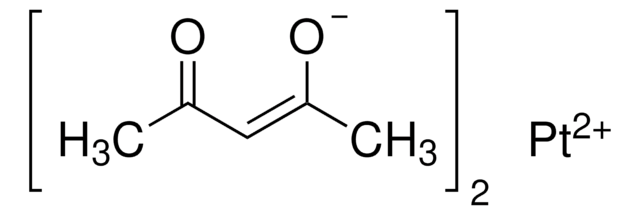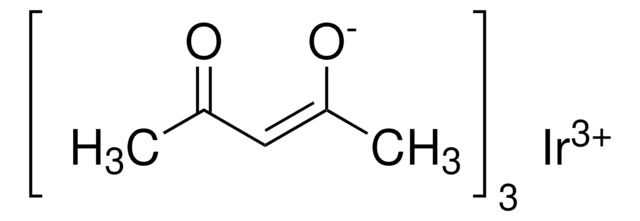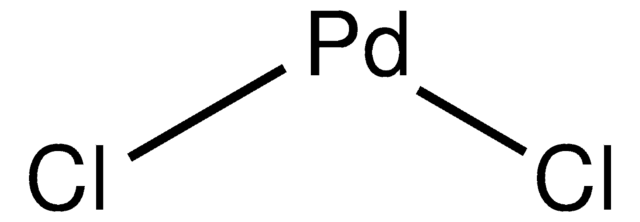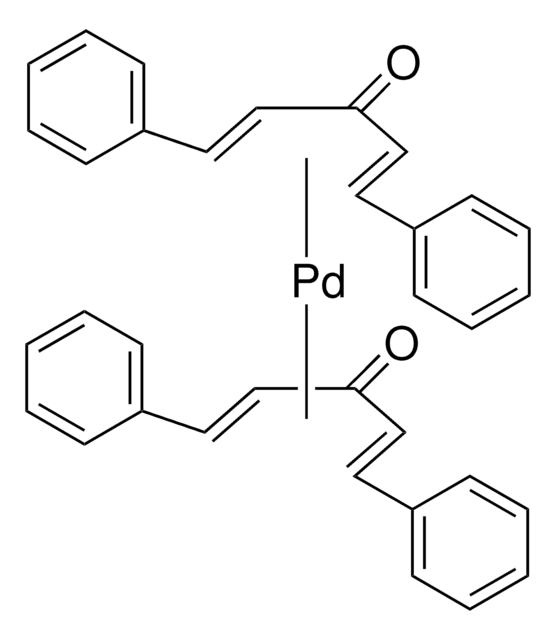209015
Palladium(II) acetylacetonate
99%
Sinónimos:
Palladium(II) 2,4-pentanedionate, Pd(acac)2
About This Item
Productos recomendados
Nivel de calidad
Análisis
99%
formulario
powder
idoneidad de la reacción
core: aluminum
reagent type: catalyst
mp
200-251 °C (dec.)
cadena SMILES
CC(=O)\C=C(\C)O[Pd]O\C(C)=C/C(C)=O
InChI
1S/2C5H8O2.Pd/c2*1-4(6)3-5(2)7;/h2*3,6H,1-2H3;/q;;+2/p-2/b2*4-3-;
Clave InChI
JKDRQYIYVJVOPF-FDGPNNRMSA-L
¿Está buscando productos similares? Visita Guía de comparación de productos
Descripción general
Aplicación
- Typical high-temperature organic solution phase protocol for the preparation of monodisperse CuPd alloy nanoparticles (NPs).
- Preparation of [(NHC)Pd(acac)L] (where L=Me, NHC = N-heterocyclic carbene) complexes. These complexes efficiently catalyze the Heck reaction of activated aryl bromides.
- As catalyst in the decarboxylative cross-coupling of arylcarboxylic acids with aryl halides.
Palabra de señalización
Warning
Frases de peligro
Consejos de prudencia
Clasificaciones de peligro
Eye Irrit. 2
Código de clase de almacenamiento
11 - Combustible Solids
Clase de riesgo para el agua (WGK)
WGK 2
Punto de inflamabilidad (°F)
Not applicable
Punto de inflamabilidad (°C)
Not applicable
Equipo de protección personal
dust mask type N95 (US), Eyeshields, Gloves
Elija entre una de las versiones más recientes:
¿Ya tiene este producto?
Encuentre la documentación para los productos que ha comprado recientemente en la Biblioteca de documentos.
Los clientes también vieron
Artículos
The Heck reaction is the palladium catalyzed cross-coupling reaction between alkenes and aryl or vinyl halides (or triflates) to afford substituted alkenes.
High Purity Metalorganic Precursors for CPV Device Fabrication
The properties of many devices are limited by the intrinsic properties of the materials that compose them.
Nuestro equipo de científicos tiene experiencia en todas las áreas de investigación: Ciencias de la vida, Ciencia de los materiales, Síntesis química, Cromatografía, Analítica y muchas otras.
Póngase en contacto con el Servicio técnico



![[Pd(OAc)2]3 reagent grade, 98%](/deepweb/assets/sigmaaldrich/product/structures/508/249/99a0ef2c-b77c-4d73-8ed9-0cca05b6b41f/640/99a0ef2c-b77c-4d73-8ed9-0cca05b6b41f.png)






